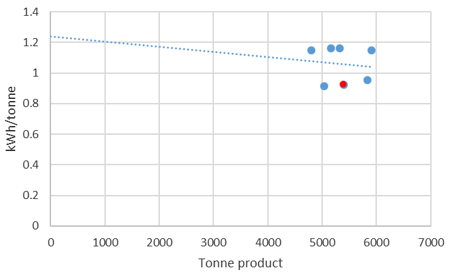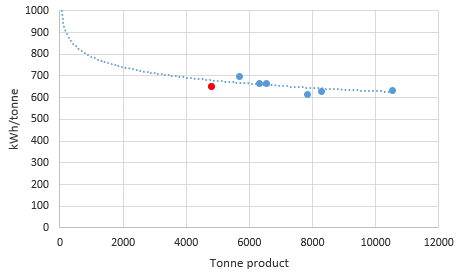Energy Efficiency
Energy efficiency is part of ICL’s comprehensive approach to reduce its environmental impact. Significant effort is invested to implement energy conservation measures in ICL’s companies and facilities worldwide. Efficiency projects range from a company-wide program to learn energy management and conservation methodologies to optimizing production equipment and creating greater awareness of the need for energy conservation among our employees and contractors. \
In early 2013 we launched a global energy efficiency program, as part of ICL’s corporate-wide ACE (Ambition Creates Excellence) efficiency program. For this purpose, we developed a standard methodology to be applied in all locations that includes creating an energy efficiency skill base within the company.
The ACE program frequently delivers significant operational savings and quality improvements beyond its core environmental aims of reducing fuel and electricity consumption as well as GHG emissions.
By the end of 2017, 26 of our largest production facilities around the world implemented this methodology. A total of 29 sites conducted the ACE process by the end of 2017 (three of whom have since been divested). During 2018, two additional sites are due to implement the methodology. Other sites are being re-visited to refresh local teams and procedures and to identify new energy efficiency opportunities. The program is well established as ICL’s principal means of improving energy efficiency. The ACE program frequently delivers significant operational savings and quality improvements beyond its core environmental aims of reducing fuel and electricity consumption as well as greenhouse gas emissions.
The main efficiency projects implemented to date include:
- optimizing the control and use of equipment used in production processes
- re-using residual heat in production plant stacks
- greater efficiency in the production of compressed air and steam
- deployment of advanced control systems for automatic shutdown of power, light and air-conditioning systems
In addition, we work to improve the awareness and behavior of employees at all levels of the organization regarding energy use and avoiding waste.

As part of the ACE program, we are implementing new and improved mandatory internal energy management systems. Individual ICL sites are either accredited to ISO 50001 by external accreditors (usually ICL’s largest energy consuming sites) or to a company standard by an internal verification panel (usually small and medium energy consuming sites). All major energy consuming sites will be accredited to ISO 50001 or the internal standard by 2020. ICL sites which have been accredited to ISO 50001 by the end of 2017 include ICL Dead Sea Works, ICL Neot-Hovav, all three sites of ICL Rotem (Rotem, Zin, Oron), four sites in ICL Germany (Bitterfeld, Ladenburg, Amfert and Knapsack), ICL The Netherlands Terneuzen and ICL China Lian Yun Gang.
Success Matrices
ICL’s ACE energy efficiency plan has reduced energy expenses by approximately USD 43 million overall in 2017 compared to the 2012 base year. The goal of the plan is to reach an annual saving of USD 46 million in energy costs by 2020 compared to 2012 (and therefore 93% of the goal was reached by the end of 2017). Cumulative energy savings since the Energy Centre of Excellence began operating in 2005 is estimated at approximately USD 155 million (not including savings from the transition to natural gas).
Some energy cost saving initiatives do not necessarily reduce the actual quantity of energy consumed. For example: adapting production and/or maintenance schedules to increase usage of lower tariff energy supplies, or converting from fuel oil to natural gas.
ICL's goal is to achieve a year-by-year improvement of energy intensity, in over 50% of all product-based intensity KPI's.
To make sure we deliver reductions in energy terms, and as part of the requirements of ISO50001, we use product-based energy intensity Key Performance Indicators (KPI’s). These KPI’s, measured in terms of MWh/tonne produced, are tracked for our main products. However, the energy consumption of a production line is frequently not linearly connected to production. Possible reasons can be:
- Product mix: Some of our product lines produce a wide and changing diversity of products every year, each with its own energy intensity, depending on customer demand and other ‘external’ market forces outside of ICL’s control.
- Production volumes: some energy needs are fixed and not dependant on production volume. Therefore, in most cases, higher volume production creates lower energy intensity. We therefore try to maximize batch volumes, but this is dependent on customer requirements.
- Weather: some sites are located in exceptionally hot or cold regions. Therefore, significant seasonal variations in energy consumption occur due to weather conditions.
For each product monitored, we create an energy intensity curve based on long-time performance (see examples below). In these examples, the blue data points are historical averages from previous years and the red data points illustrate data for the most recent quarter. An improvement in the KPI is achieved if the quarterly reported intensity is below the nominal curve, and a setback is considered if the intensity is located above the curve.


Our goal is to achieve a year-by-year improvement in over 50% of all product-based intensity KPI’s. In 2017, 15 of 23 products (65%) showed annual average improvement, achieving the annual target. We plan to expand the number of products monitored in 2018.
In 2017, 65% of products showed an annual average improvement.

